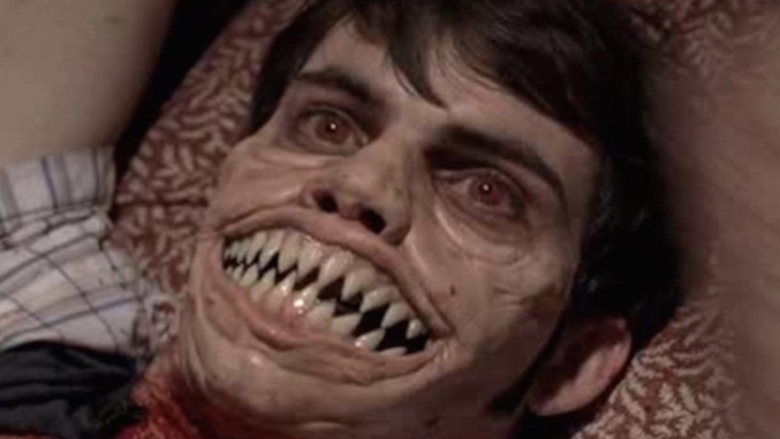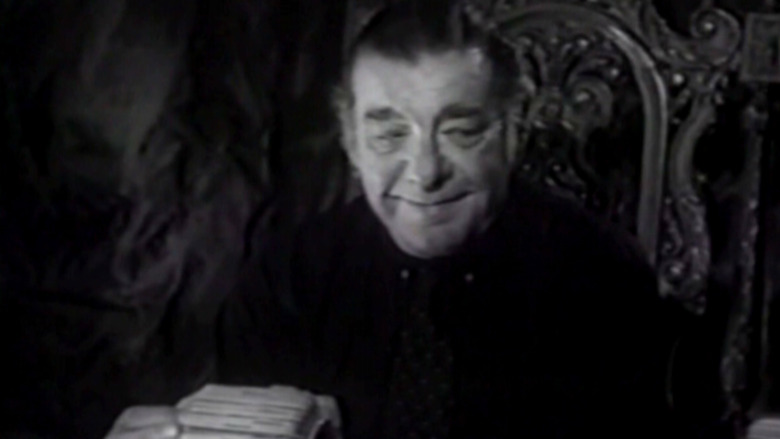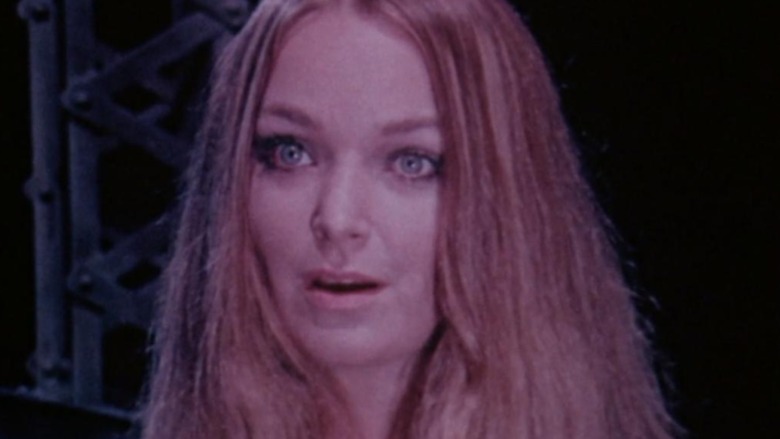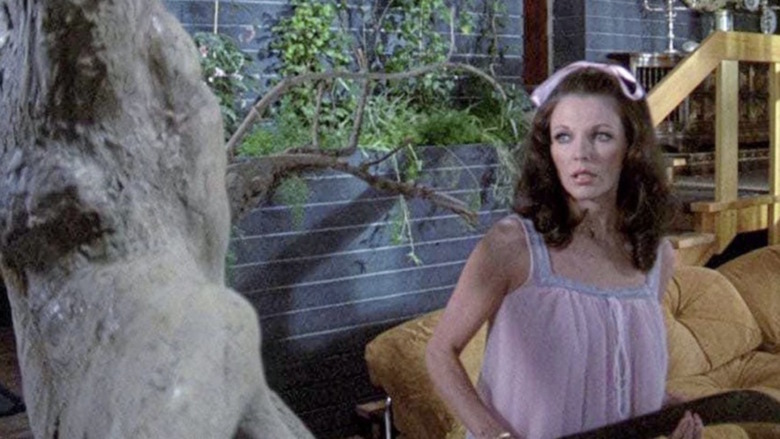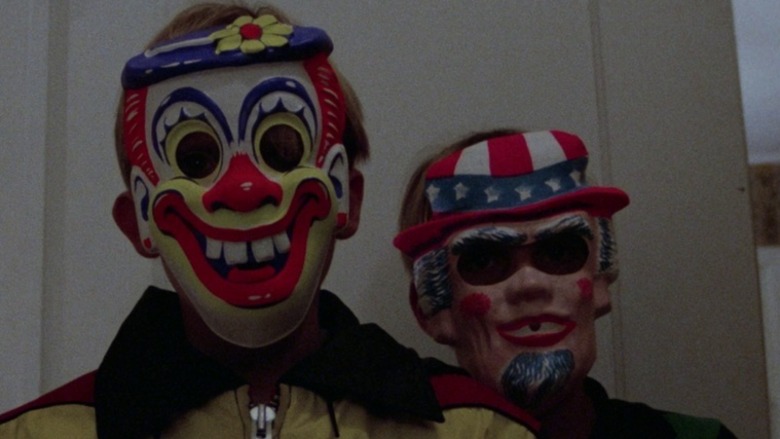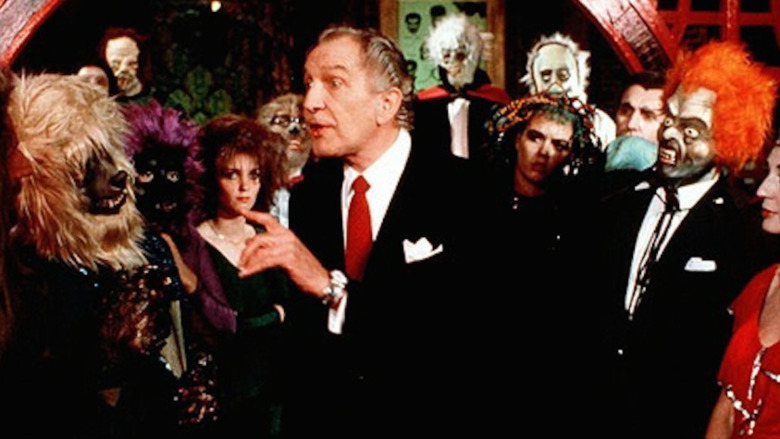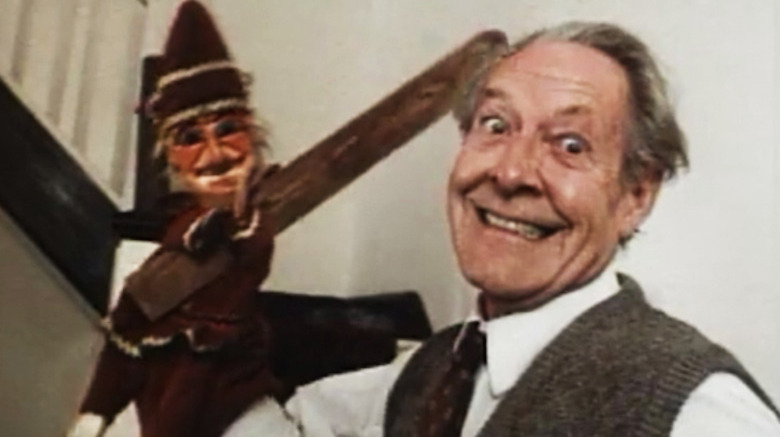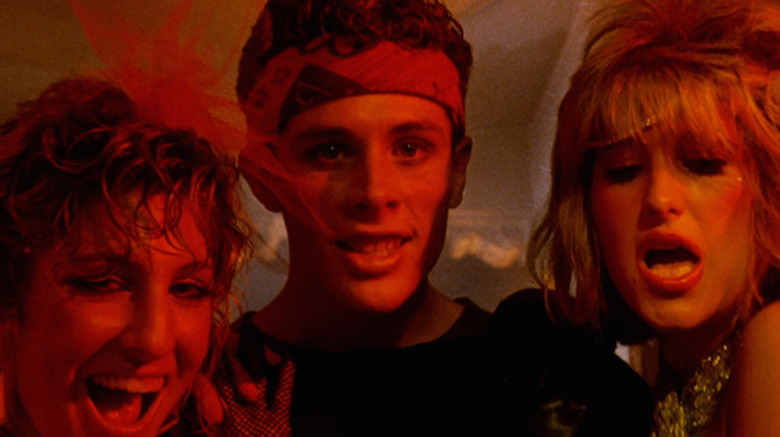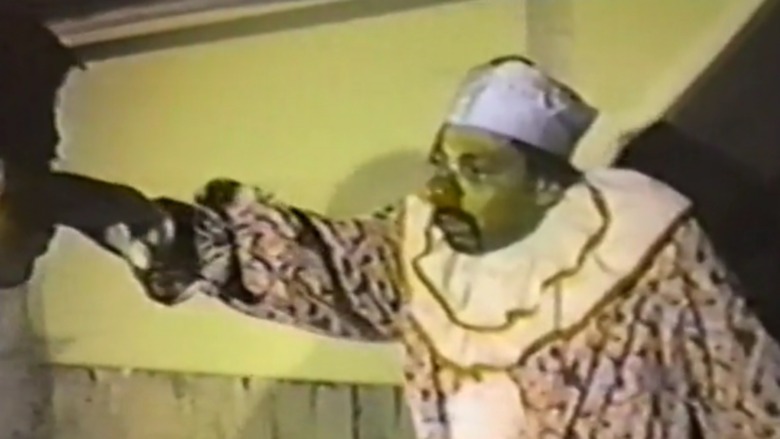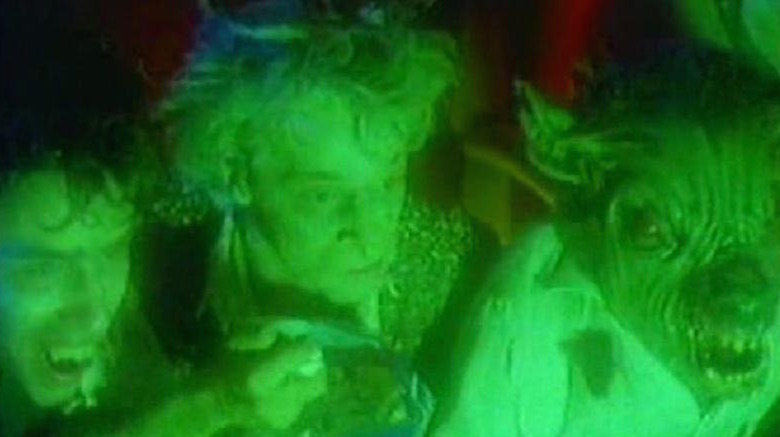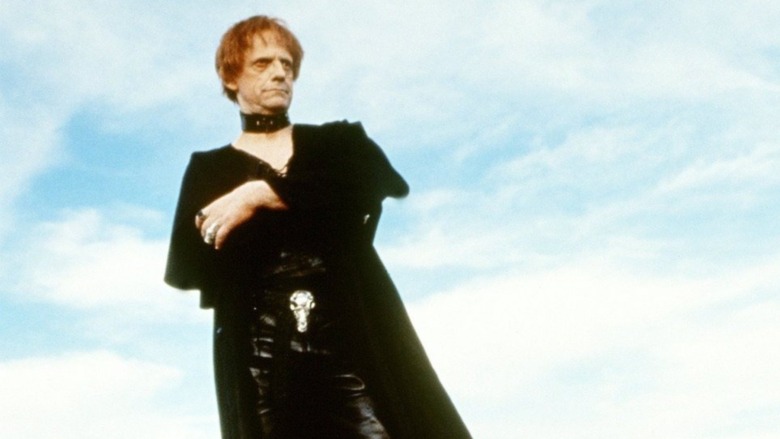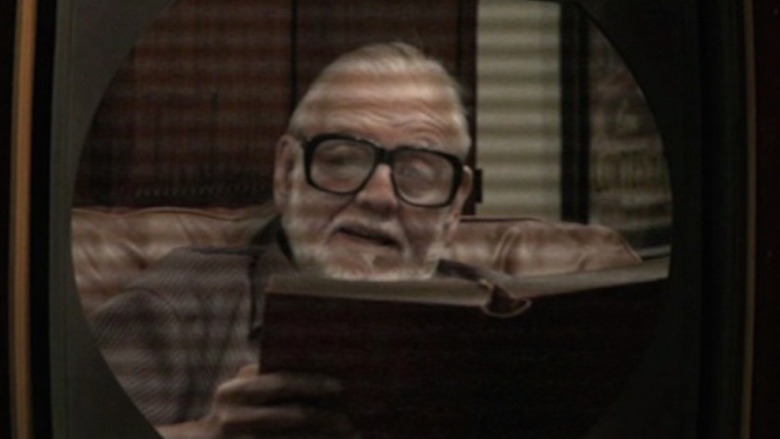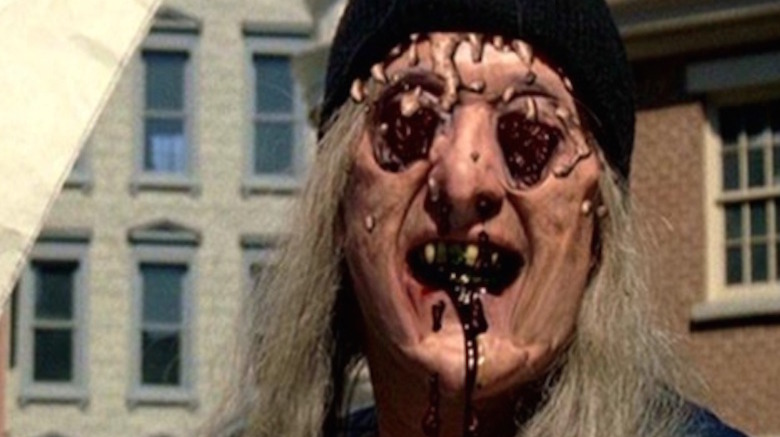Weird And Ridiculous Horror Anthology Movies
Creating a horror anthology is easy, right? Round up some scary stories, stitch them together with a framing device of some kind — a creepy storyteller will do — and watch the money roll in. But, as many creative types will tell you, it can be as hard to frighten people with a short film or story than it is with a full-length film or novel. Pacing is crucial — stories need to be almost immediately compelling and pack their time with enough shocks to rival a horror feature. The history of horror anthology movies has more than a few films that managed that balancing act: 1945's Dead of Night, George Romero and Stephen King's 1982 collaboration Creepshow, and more recently, the V/H/S and ABCs of Death franchises.
But there are also many horror anthologies that weren't able to pull off big scares in a short amount of time, and streaming services have plenty of well-intentioned but totally inert collections of short chillers. Some simply aimed for something different or bizarre within the art of the anthology. While far from good (or, in some cases, even coherent), this sub-cellar of horror anthologies achieve their own unique takes on the format. One thing is for sure: the films included in this list are in many cases weird or ridiculous (or both), but they're never dull.
Please note that spoilers will follow.
The Devil's Messenger is Swedish horror for Stateside viewers
Question: When is an American horror anthology movie not an American horror anthology? Answer: When it's stitched together from three episodes of a Swedish horror series. The Devil's Messenger, which played theaters in 1961 on an undoubtedly mind-bending double bill with Carnival of Souls, was culled from 13 Demon Street, a 1959 horror anthology series created and directed by Curt Siodmak, who shot the series in Sweden but with English-language dialogue. Siodmak, who's best known for writing Universal's 1941 The Wolf Man, also tapped that film's star, Lon Chaney, Jr., to host the show as a man condemned to Purgatory whose only chance for escape was to convince the viewer that the characters in each week's story had committed worse crimes than his.
The series was never picked up in the United States, but director Herbert L. Strock (I Was a Teenage Frankenstein) reworked three of them for Devil's Messenger and rehired Chaney as host. Here, he's Satan himself, who sends a suicide victim (Karen Kadler) to Earth to recruit souls for Hell. Footage of Kadler is awkwardly inserted into the episodes, which are all minor efforts — a man is haunted by his murder victim, a scientist falls in love with a frozen cave woman, etc. But the final episode finds Kadler bringing the man who caused her demise to Chaney, who then gives them a new assignment: deliver the formula for the atom bomb to humanity!
Submitted for your approval: Rod Serling and Arkansas horror
In the years that followed Twilight Zone and Night Gallery, Rod Serling lent his distinctive voice to all manner of projects, from Phantom of the Paradise and TV spots for Ford to the curious 1973 supernatural anthology Encounter with the Unknown, which was lensed in Arkansas and featured stories reportedly based in fact. The latter part is most likely baloney, as are the stories themselves, which concern curses, ghostly passengers, and a mysterious hole in the ground that drives a man insane.
Director and co-writer Harry Thomason –- who later co-created Evening Shade and Designing Women with his wife, Linda Bloodworth-Thomason -– most likely based two of the stories on the popular urban legends about the Vanishing Hitchhiker and Well to Hell, but isn't able to turn the pulpy shivers behind those stories into anything substantial onscreen (though he does get an unintentionally hilarious performance out of the actor who is lowered into the infernal hole). Serling's narration is professional, if perfunctory; he would offer equally world-weary voice-over for the 1974 documentary, UFOs: Past, Present, and Future, and three made-for-TV paranormal documentaries that inspired the cult series In Search Of...
Get an eyeful of Tales That Witness Madness
Grisly stories of supernatural revenge fuel 1973's Tales That Witness Madness, a British-made horror anthology fashioned after the portmanteau chillers by Amicus Films, including Tales from the Crypt and Vault of Horror. Madness, produced by World Film Services, boasts solid direction and visuals by Academy Award-winning cinematographer Freddie Francis, with a capable cast led by Halloween's Donald Pleasence as a psychiatrist at a clinic and Jack Hawkins as his visiting colleague. The clinic –- itself a carbon of Amicus' 1972 anthology Asylum –- provides the link to four stories, all concerning patients under Pleasence's care. As penned by actress Jennifer Jayne, the stories are among the most unusual featured in any anthology film, British or otherwise.
In "Mr. Tiger," young Russell Lewis finds an escape from his warring parents in an imaginary and very aggressive tiger, while in "Mel," artist Michael Jayston (the Valeyard to Colin Baker's Sixth Doctor) angers wife Joan Collins by lavishing attention on a dead tree with a decidedly female shape and a homicidal streak. The last story, "Luau," is notable for an appearance by Kim Novak and an utterly bonkers (and undoubtedly offensive) premise involving a feast for a Hawaiian celebrity that turns into a cannibal sacrifice. After that, the conclusion, which finds Pleasence completely mad (no surprise there) and Hawkins ripped to shreds by Mr. Tiger, seems almost genteel.
Midwestern malevolence lives in The House of the Dead
The 1978 anthology The House of the Dead (also known as Alien Zone) was directed by Sharron Miller, an Emmy and Peabody Award winner for her work on TV in the '70s and '80s. House of the Dead isn't on par with her small screen efforts, but it is a very weird anthology all the same. Writer and fellow TV vet David O'Malley (The Boogens) concocts a framing device involving sinister small town mortician Ivor Francis, who informs unexpected guest (or is he?) John Ericson about the fate of four newly embalmed corpses.
There's a schoolteacher whose dislike for her students proves fatal, a psychopath who films his murders, a pair of top sleuths from America and Britain who challenge each other to solve a bizarre mystery, and a jerk whose disdain for the homeless gets a Twilight Zone-style comeuppance. Shot in a static style that betrays its low budget -– it was filmed in Oklahoma using broadcast students from the state college as crew – House still surprises by occasionally rising above its amateur night aesthetic with creepy scenarios and capable acting from Hollywood vets Charles Aidman and Bernard Fox (Bewitched) as the warring crime solvers.
Children of the night get down at The Monster Club
Based loosely on stories by British author R. Chetwynd-Hayes, The Monster Club stars John Carradine as a fictionalized Hayes, whose encounter with a hungry vampire (Vincent Price) gains him entry into the titular establishment, a nightclub for supernatural creatures. There, Price regales Carradine with three stories about human-monster hybrids.
The first concerns a creature that can kill with its whistle, and the last is about a horror director who discovers that the location for his next picture actually houses monsters (the other story, starring Donald Pleasence as a comic vampire hunter, is silly fluff). Director Roy Ward Baker, a veteran of both Hammer Films and British television, buoys the material with suspense and atmosphere under what appears to be a tight budget. But his hard work (and the good will generated by Price, Carradine, and Pleasence) is undone by the ridiculous club scenes, which feature extras in cheap Halloween masks and glum musical numbers, including the title track by the Pretty Things.
Three UK horror shorts make up the anthology Screamtime
The 1983 British horror anthology feature Screamtime is actually a compilation of three theatrically released shorts made by producer Stanley A. Long –- best known for an endless string of '70s-era adults-only comedies like Adventures of a Plumber's Mate –- and writer-director Michael Armstrong, whose gruesome 1970 film Mark of the Devil is forever enshrined in exploitation history for its use of airline vomit bags as a promotional gimmick. Nothing in Screamtime quite lives up to that high-water mark of nastiness, but it's still a surprisingly effective low-budget scare film with some amusing eccentricities.
Armstrong and Long link the three shorts through a framing story featuring a couple of deadbeats who steal VHS horror titles from the real-life Video Shack in Deuce-era Manhattan before schlepping to a friend's apartment to enjoy their ill-gotten gains. Their haul offers up supernatural revenge in the form of a homicidal puppet that gets revenge on the goons who tried to ruin their owner's Punch and Judy show, a new house owner plagued by bloody visions of a serial killer's crimes, and a desperate type (played by UK pop singer David Van Day) learning the hard way that his seemingly senile employers' stories of treasure protected by gnomes are true. The second story, "Dreamhouse," was expanded to feature length for the 2010 film Psychosis, starring Charisma Carpenter.
God, the Devil and breakdancing in Night Train to Terror
Like Screamtime, 1985's Night Train to Terror is a patchwork anthology, cobbled together Frankenstein-like, from trimmed-down versions of three other no-budget horror films. And one of those -– 1981's wonderfully titled Scream Your Head Off –- wasn't even completed. But while Screamtime manages to (mostly) rise above its mix-and-match origins, Night Train to Terror is an incoherent mess, made even more baffling by its wrap-around story, which features a debate between God (Ferdy Mayne of The Fearless Vampire Killers) and Satan (The Godfather's Tony Giorgio) discussing three stories to determine the fates of their protagonists.
The stories are sloppy splatter nonsense –- Richard Moll of Night Court turns up as an attendant at an asylum whose job description seems to concern dismembering victims, and then appears in a completely different role opposite slumming Hollywood vet Cameron Mitchell in a segment about cults. Between the heavenly/diabolical debate and the horror stories, we're also treated to endless footage of a terrible pop-rock band performing the same song over and over.
Night Train to Terror's script comes courtesy of screenwriter Philip Yordan, who won an Oscar for the 1954 western Broken Lance. No matter how far down the movieland ladder Mr. Yordan fell, he might be the only writer who can claim both an Oscar and a script about God, Satan, psycho, cultists, and a crappy rock band on a train (which crashes in the film's conclusion) as part of the same career.
Nothing can prepare you for Tales from the QuadeaD Zone
Chicago-based filmmaker Chester Novell Turner's first film, 1984's Black Devil Doll from Hell, was a mind-blistering, no-budget supernatural thriller about a demonically possessed doll that upends the life of a church-going young woman (Shirley L. Jones). Made for about $10,000 and featuring an aesthetic somewhere south of backyard creature feature, Doll became a cult hit on the VHS circuit; Turner, who made no money on the film thanks to his deal with the distributor, returned with 1987's Tales from the QuadeaD Zone, a 62-minute anthology film soaked in his uniquely ham-fisted directorial and writing style.
Jones returned to star in Zone's linking device –- a woman reading the titular book to the ghost of her dead son -– while the stories themselves seem to be very weird riffs on sibling rivalry (a hillbilly family has a grisly but direct way of solving a food shortage problem, and two brother carry out a bizarre feud even after one of them dies). While it's true that Turner is barely capable of even the most rudimentary filmmaking technique, the lack of self-referential humor seems to indicate QuadeaD is serious business for him, and as such, deserves at least a nod of respect. Oh, and if you're wondering what in the world "Quadead" means, Turner said in an interview with the Chicago Tribune that quad means four, and the dead part is self-evident. Got that?
Maybe CreepTales should have stayed buried
How many times has this happened to you? You try to watch your favorite horror film on Halloween, but no matter how hard you try, it's unavailable from every possible source. So once again, you have to go to your uncle's grave and dig up the copy he was buried with, all for a few minutes of scary laughs. That's exactly what happens in the sleazy horror anthology CreepTales.
The six stories featured here — introduced with a framing segment involving two goofballs who dig up a VHS tape from their relative's final resting place — are the usual horror shenanigans with a twist in their tail, and none with a particularly memorable moment to them. But the directors who oversaw the individual segments are a surprising mix of future talents and cult favorites, including Emmy-nominated editor and Trekkies director Roger Nygard, VFX designer and artist Tim Boxell (Virtuosity), documentarian Ken Mandel, and early direct-to-VHS horror filmmaker Rod Slane. Oh, and that goofball running around in Boxell's "Snatcher" segment? That's Tom Kenny of Mr. Show and SpongeBob SquarePants fame.
King and Barker can't save Quicksilver Highway
Writer-producer-director Mick Garris has been involved in a tremendous amount of horror content for films and television, some of which has been fairly good (the Masters of Horror and Monsterland series, not to mention Hocus Pocus) and some not so good (Sleepwalkers). He's also written or directed a lot of Stephen King material for both mediums, including miniseries takes on The Stand in 1994 and The Shining in 1997, as well as 1996's Desperation and 2011's Bag of Bones.
Somewhere between all of these efforts was Quicksilver Highway, a two-part anthology intended as a pilot for an ABC series. Garris, who wrote the script for the pilot, also stepped in as director for its two episodes: King's comic horror vignette "Chattery Teeth" and Clive Barker's more unsettling "The Body Politic," about our hands rebelling against us. Christopher Lloyd, tricked out in quasi-bondage gear and an ill-fitting wig, handles host duties as a mysterious traveler who shares creepy stories with those he encounters on the road.
Lloyd is fine and the cast, which includes Matt Frewer and Alien's Veronica Cartwright (plus Barker, Garris, and John Landis all turning up in cameos), is game, but ultimately it's too lighthearted and lightweight in the scares department to make any sort of an impression. Needless to say, the pilot never went to series.
George Romero can't reanimate Deadtime Stories
The Deadtime Stories films -– not to be confused with a 1986 horror anthology film of the same name, or the 2012 Nickelodeon kids' suspense series –- were two indie collections of shiver stories released in 2009 and 2011, co-written, co-produced, and co-directed by Jeff Monahan, an actor and writer whose personal and professional connection to George A. Romero led to the zombie auteur not only helping to produce the two films, but also serve as their host.
Romero, featured in his signature oversized glasses, is game to play Crypt Keeper but can't really generate any sense of foreboding or impending creeps –- a situation not alleviated by the half-baked stories. The best of the lot in Deadtime Vol. 1 is "House Call," a riff on Romero's Martin directed by special effects legend Tom Savini; there is no best of the lot in Deadtime Vol. 2, though that iteration pours on the stage blood. Either way, they're both plagued by thin material made no less palatable by the presence of a horror legend in front of the camera.
Creepshow 3: No comics, no King, no scares
An in-name-only sequel to 1982's Romero/King horror comics tribute Creepshow and its 1988 sequel, 2006's Creepshow 3 dispenses with any connection to comic books after a desultory animated sequence and a last-minute appearance by the Creep (sort of), and dives into five absurd and ill-conceived horror vignettes. The best of the lot is probably "The Radio," with indie horror vet A.J. Bowen (the only recognizable name in the film, save for a brief appearance by Eileen Dietz of The Exorcist fame) as a schlub of a security guard whose new radio gradually pushes him to commit crimes, including murder.
The others involve a jerk of a doctor who is haunted by a homeless man who died after eating his discarded hot dog (yes, really), a pair of dopes who come to believe that the new wife of their college professor is a robot, and a psychopathic escort who discovers that her latest date is not an easy mark. The filmmakers get a nod for attempting to link the episodes by carrying over characters in each story, but that isn't enough to save Creepshow 3 from the bottom of the horror anthology pile (a fact borne out by its 0% rating on Rotten Tomatoes).
